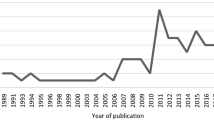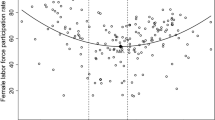Abstract
The purpose of this paper is to analyze the main socio-cultural factors that influence women entrepreneurship in Catalonia, using institutional economics as a theoretical framework. The empirical research employs logistic regression models (rare events logit), utilizing data obtained from the Global Entrepreneurship Monitor project (GEM). The main findings highlight that ‘fear of failure’ and ‘perceived capabilities’ are the most important socio-cultural factors on the probability of becoming a woman entrepreneur. The research contributes both theoretically, advancing knowledge of the socio-cultural factors that affect female entrepreneurship, and practically, helping in the development of educational programmes and support policies to promote entrepreneurial activity.
Similar content being viewed by others
Notes
Catalonia is one of the richest Spanish regions (INE 2012).
GEM is the largest ongoing study of entrepreneurial dynamics in the world. For more information see http://www.gemconsortium.org/
References
Ahl, H. J. (2002). The making of the female entrepreneur: A discourse analysis of research texts on women’s entrepreneurship. Doctoral Dissertation. JIBS Dissertation Series nº 015 Jönköping International Business School.
Aidis, R., Estrin, S., & Mickiewicz, T. (2008). Institutions and entrepreneurship development in Russia: a comparative perspective. Journal of Business Venturing, 23(6), 656–672.
Aldrich, H. E., & Zimmer, C. (1986). Entrepreneurship through social networks. In D. Sexton & R. Smilor (Eds.), The art and science of entrepreneurship (pp. 3–23). New York: Ballinger.
Alvarez, C., & Urbano, D. (2011). Environmental factors and entrepreneurial activity in Latin America. Academia, Revista Latinoamericana de Administración, 48, 31–45.
Anderson, A. R., Dodd, S. D., & Jack, S. L. (2012). Entrepreneurship as connecting: some implications for theorising and practice. Management Decision, 50(5), 958–971.
Anna, A. L., Chandler, G. N., Jansen, E., & Mero, N. P. (1999). Women business owners in traditional and nontraditional industries. Journal of Business Venturing, 15, 279–303.
Arenius, P., & Minniti, M. (2005). Perceptual variables and nascent entrepreneurship. Small Business Economics, 24(3), 233–247.
Audretsch, D. (2012). Entrepreneurship research. Management Decision, 50(5), 755–764.
BarNir, A. (2012). Starting technologically innovative ventures: reasons, human capital, and gender. Management Decision, 50(3), 399–419.
BarNir, A., Watson, W., & Hutchins, M. (2011). Mediation and moderated mediation in the relationship among role models, self-efficacy, entrepreneurial career intention, and gender. Journal of Applied Social Psychology, 41(2), 270–297.
Baron, R., Markman, G., & Hirza, A. (2001). Perceptions of women and men as entrepreneurs: evidence for differential effects of attributional augmenting. The Journal of Applied Psychology, 86(5), 923–929.
Battistella, C., Biotto, G., & De Toni, A. (2012). From design driven innovation to meaning strategy. Management Decision, 50(4), 718–743.
Baughn, C., Chua, B. L., & Neupert, K. E. (2006). The normative context for women’s participation in entrepreneurship: a multicountry study. Entrepreneurship Theory and Practice, 30(5), 687–708.
Berger, B. (1991). The culture of entrepreneurship. San Francisco: ICS Press.
Bhasin, S. (2012). An appropriate change strategy for lean success. Management Decision, 50(3), 439–458.
Blanchflower, D. G. (2004). Self-employment: More may not be better. NBER Working Paper nº.10286. Cambridge: National Bureau of Economic Research.
Boyd, N. G., & Vozikis, G. S. (1994). The influence of self-efficacy on the development of entrepreneurial intentions and actions. Entrepreneurship Theory and Practice, 18(4), 63–77.
Brush, C., de Bruin, A., & Welter, F. (2009). A gender-aware framework for women’s entrepreneurship. International Journal of Gender and Entrepreneurship, 1(1), 8–24.
Cegarra-Navarro, J. G., Sánchez-Vidal, M. E., & Cegarra-Leiva, D. (2011). Balancing exploration and exploitation of knowledge through an unlearning context: an empirical investigation in SMEs. Management Decision, 49(7), 1099–1119.
Chang, Y. Y., Hughes, M., & Hotho, S. (2011). Internal and external antecedents of SMEs’ innovation ambidexterity outcomes. Management Decision, 49(10), 1658–1676.
Chaston, I., & Scott, G. J. (2012). Entrepreneurship and open innovation in an emerging economy. Management Decision, 50(7), 1161–1177.
Chen, C. C., Green, P. G., & Crick, A. (1998). Does entrepreneurial self-efficacy distinguish entrepreneurs from managers? Journal of Business Venturing, 13(4), 295–316.
Coduras, A., Urbano, D., Rojas, A., & Martínez, S. (2008). The relationship between university support to entrepreneurship with entrepreneurial activity in Spain: a GEM data based analysis. International Advances in Economic Research., 14(4), 395–406.
Conroy, D. E., Willow, J. P., & Metzler, J. N. (2002). Multidimensional fear of failure measurement: the performance failure appraisal inventory. Journal of Applied Sport Psychology, 14(2), 76–90.
Cormier, D., Ledoux, M. J., & Magnan, M. (2011). The informational contribution of social and environmental disclosures for investors. Management Decision, 49(8), 1276–1304.
Curado, C., Henriques, L., & Bontis, N. (2011). Intellectual capital disclosure payback. Management Decision, 49(7), 1080–1098.
Davidsson, P., & Honig, B. L. (2003). The role of social and human capital among nascent entrepreneurs. Journal of Business Venturing, 18(3), 301–331.
De Bruin, A., Brush, C., & Welter, F. (2007). Advancing a framework for coherent research on women’s entrepreneurship. Entrepreneurship Theory & Practice, 31(3), 323–39.
DeTienne, D. R., & Chandler, G. N. (2007). The role of gender in opportunity identification. Entrepreneurship Theory and Practice, 31(3), 365–386.
Díaz-García, M. C., & Jiménez-Moreno, J. (2010). Entrepreneurial intention: the role of gender. International Entrepreneurship and management Journal, 6(3), 261–283.
Dinur, A. R. (2011). Common and un-common sense in managerial decision making under task uncertainty. Management Decision, 49(5), 694–709.
Douglas, E., & Shepherd, D. A. (1999). Entrepreneurship as a utility maximizing response. Journal of Business Venturing, 15(3), 231–251.
Ekelund, J., Johansson, E., Järvelin, M., & Lichtermann, D. (2005). Self-employment and risk aversion—evidence from psychological test data. Labour Economics, 12, 649–659.
Evans, D. S., & Leighton, L. S. (1989). Some empirical aspects of entrepreneurship. The American Economic Review, 79(3), 519–535.
Gatewood, E. J., Shaver, K. G., Powers, J. B., & Gartner, W. B. (2002). Entrepreneurial expectancy, task effort and performance (pp. 95–114). Winter: Entrepreneurship Theory and Practice.
Gnyawali, D. R., & Fogel, D. S. (1994). Environments for entrepreneurship development: key dimensions and research Implications. Entrepreneurship Theory and Practice, 18(4), 43–62.
Gómez-Haro, S., Aragón-Correa, J. A., & Cordón-Pozo, E. (2011). Differentiating the effects of the institutional environment on corporate entrepreneurship. Management Decision, 49(10), 1677–1693.
Güemes, J. J., Coduras, A., Rachida, C. C., & Pampillón, R. (2011). Global entrepreneurship monitor Informe Ejecutivo 2010-España. Madrid: I E, Business School.
Gupta, V. K., & Bhawe, N. M. (2007). The influence of proactive personality and stereotype threat on women’s entrepreneurial intentions. Journal of Leadership and Organizational Studies, 13(4), 73–85.
Hernández, R., Coduras, A., Díaz, J. C., De la Cruz, M., Vaillant, Y., & Lafuente, E. (2012). Global entrepreneurship monitor Informe Ejecutivo 2010-España. Cáceres: Fundación Xavier de Salas.
Hotho, S., & Champion, K. (2011). Small businesses in the new creative industries: innovation as a people management challenge. Management Decision, 49(1), 29–54.
Huarng, K. H., & Yu, T. H. K. (2011). Entrepreneurship, process innovation and value creation by a non-profit SME. Management Decision, 49(2), 284–296.
INE (National Statistics Institute - Spain) (2012). Spanish regional accounts. Available at http://www.ine.es/. January 10, 2013.
Katz, J. A. (1992). A psychosocial cognitive model of employment status choice. Entrepreneurship Theory and Practice, 17(1), 29–29.
King, G., & Zeng, L. (2001). Explaining rare events in international relations. International Organization, 55(3), 693–715.
Kirby, D. A. (2004). Entrepreneurship education: can business schools meet the challenge. Education and Training, 46(8/9), 510–519.
Kirzner, I. (1973). Competition and entrepreneurship. Chicago: University of Chicago Press.
Kirzner, I. (1979). Perception, opportunity, and profit. Chicago: University of Chicago Press.
Koellinger, P., Minniti, M., & Schade, C. (2005). “I think I can, I think I can”: Overconfidence and entrepreneurial behavior. Discussion Papers 501, German Institute for Economic Research.
Koellinger, P., Minniti, M., & Schade, C. (2011). Gender differences in entrepreneurial propensity. Oxford bulletin of economics and statistics. doi:10.1111/j.1468-0084.2011.00689.x.
Langowitz, N., & Minniti, M. (2007). The entrepreneurial propensity of women. Entrepreneurship Theory and Practice, 31, 341–364.
Langowitz, N., Sharpe, N., & Godwyn, M. (2006). Women’s business centers in the United States: effective entrepreneurship training and policy implementation. Journal of Small Business & Entrepreneurship, 19(2), 167–181.
Levesque, M., & Minniti, M. (2006). The effect of aging on entrepreneurial behavior. Journal of Business Venturing, 21(2), 177–194.
Liñán, F., Urbano, D., & Guerrero, M. (2011). Regional variations in entrepreneurial cognitions: start-up intentions of university students in Spain. Entrepreneurship and Regional Development., 23(3–4), 187–215.
Marlow, S., & Patton, D. (2005). All credit to men? Entrepreneurship, finance, and gender. Entrepreneurship Theory and Practice, 29(6), 717–735.
Menzies, T. V., & Tatroff, H. (2006). The propensity of male versus female students to take courses and degree concentrations in entrepreneurship. Journal of Small Business and Entrepreneurship, 19(2), 203–218.
Minniti, M., & Nardone, C. (2007). Being in someone else’s shoes: the role of gender in nascent entrepreneurship. Small Business Economics, 28, 223–238.
Mousa, F. T., & Wales, W. (2012). Founder effectiveness in leveraging entrepreneurial orientation. Management Decision, 50(2), 305–324.
Naranjo-Valencia, J. C., Jiménez-Jiménez, D., & Sanz-Valle, R. (2011). Innovation or imitation? The role of organizational culture. Management Decision, 49(1), 55–72.
Nilsson, P. (1997). Business counselling services directed towards female entrepreneurs—some legitimacy dilemmas. Entrepreneurship and Regional Development, 9(3), 239–258.
North, D. C. (1990). Institutions, institutional change and economic performance. Cambridge: Cambridge University Press.
North, D. C. (2005). Understanding the process of economic change. Princeton: Princeton University Press.
Reed, R., Storrud-Barnes, S., & Jessup, L. (2012). How open innovation affects the drivers of competitive advantage: trading the benefits of IP creation and ownership for free invention. Management Decision, 50(1), 58–73.
Renko, M., Shrader, R. C., & Simon, M. (2012). Perception of entrepreneurial opportunity: a general framework. Management Decision, 50(7), 1233–1251.
Ribeiro-Soriano, D., & Urbano, D. (2009). Overview of collaborative entrepreneurship: an integrated approach between business decisions and negotiations. Group Decision and Negotiation, 18(5), 419–430.
Scherer, R. F., Brodzinski, J., & Wiebe, F. A. (1990). Entrepreneur career selection and gender: a socialization approach. Journal of Small Business Management, 28(2), 37–44.
Schiller, B., & Crewson, P. (1997). Entrepreneurial origins: a longitudinal inquiry. Economic Inquiry, 35(3), 523–529.
Shane, S., & Venkataraman, S. (2000). The promise of entrepreneurship as a field of research. Academy of Management Review, 25, 217–226.
Shapero, A., & Sokol, L. (1982). The social dimensions of entrepreneurship. In C. A. Kent, D. L. Sexton, & K. H. Vesper (Eds.), Encyclopedia of entrepreneurship (pp. 72–90). Englewood Cliffs: Prentice-Hall. Inc.
Siegel, D. S., & Renko, M. (2012). The role of market and technological knowledge in recognizing entrepreneurial opportunities. Management Decision, 50(5), 797–816.
Thornton, P., Ribeiro-Soriano, D., & Urbano, D. (2011). Socio-cultural factors and entrepreneurial activity: an overview. International Small Business Journal, 29(2), 105–118.
Urbano, D., & Yordanova, D. (2008). Determinants of the adoption of HRM practices in tourism SMEs in Spain: an exploratory study. Service Business, 2(3), 167–185.
Urbano, D., Toledano, N., & Ribeiro-Soriano, D. (2011). Socio-cultural factors and transnational entrepreneurship: a multiple case study in Spain. International Small Business Journal, 29(2), 119–134.
Van Auken, H., Fry, F. L., & Stephens, P. (2006). The influence of role models on entrepreneurial intentions. Journal of Developmental Entrepreneurship, 11, 157–167.
Venkataraman, S. (1997). The distinctive domain of entrepreneurship research: an editor’s perspective. Advances in Entrepreneurship, Firm Emergence and Growth, 3, 119–138.
Verheul, I., Uhlaner, L., & Thurik, R. (2003). Business accomplishments, gender and entrepreneurial selfimage. SCALES (Scientific Analysis of Entrepreneurship and SMEs)- paper nº 200312, EIM Business and Policy Research.
Wagner, J. (2007). What a difference a Y makes-female and male nascent entrepreneurs in Germany. Small Business Economics, 28, 1–21.
Welter, F., & Smallbone, D. (2011). Institutional perspectives on entrepreneurial behaviour in challenging environments. Journal of Small Business Management, 49(1), 107–125.
White, H. (1980). A heteroskedasticity-consistent covariance matrix estimator and a direct test for heteroskedasticity. Econometrica, 48, 817–830.
Wilson, F., Kickul, J., & Marlino, D. (2007). Gender, entrepreneurial self-efficacy, and entrepreneurial career intentions: implications for entrepreneurship education. Entrepreneurship Theory & Practice, 31(3), 387–406.
Yang, T. T., & Li, C. R. (2011). Competence exploration and exploitation in new product development: the moderating effects of environmental dynamism and competitiveness. Management Decision, 49(9), 1444–1470.
Acknowledgments
The authors acknowledge the financial support from the Projects ECO2010-16760 (Spanish Ministry of Science and Innovation) and 2005SGR00858 (Catalan Government Department for Universities, Research and Information Society).
Author information
Authors and Affiliations
Corresponding author
Rights and permissions
About this article
Cite this article
Noguera, M., Alvarez, C. & Urbano, D. Socio-cultural factors and female entrepreneurship. Int Entrep Manag J 9, 183–197 (2013). https://doi.org/10.1007/s11365-013-0251-x
Published:
Issue Date:
DOI: https://doi.org/10.1007/s11365-013-0251-x




